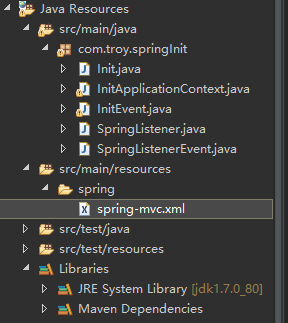1、ApplicationListener在使用过程中可以监听某一事件的发生,可以做出相应的处理,这个方式不常用,但是在特殊情况下面还是有用的。
2、导包pom.xml
<project xmlns="http://maven.apache.org/POM/4.0.0" xmlns:xsi="http://www.w3.org/2001/XMLSchema-instance" xsi:schemaLocation="http://maven.apache.org/POM/4.0.0 http://maven.apache.org/xsd/maven-4.0.0.xsd"> <modelVersion>4.0.0</modelVersion> <groupId>com.troy</groupId> <artifactId>springInit</artifactId> <version>0.0.1-SNAPSHOT</version> <packaging>war</packaging> <dependencies> <dependency> <groupId>org.springframework</groupId> <artifactId>spring-webmvc</artifactId> <version>3.2.8.RELEASE</version> </dependency> </dependencies> </project>
3、web.xml配置
<?xml version="1.0" encoding="UTF-8"?> <web-app xmlns:xsi="http://www.w3.org/2001/XMLSchema-instance" xmlns="http://java.sun.com/xml/ns/javaee" xsi:schemaLocation="http://java.sun.com/xml/ns/javaee http://java.sun.com/xml/ns/javaee/web-app_2_5.xsd" version="2.5"> <display-name>springInit</display-name> <welcome-file-list> <welcome-file>index.html</welcome-file> <welcome-file>index.htm</welcome-file> <welcome-file>index.jsp</welcome-file> <welcome-file>default.html</welcome-file> <welcome-file>default.htm</welcome-file> <welcome-file>default.jsp</welcome-file> </welcome-file-list> <servlet> <servlet-name>springmvc</servlet-name> <servlet-class>org.springframework.web.servlet.DispatcherServlet</servlet-class> <init-param> <param-name>contextConfigLocation</param-name> <param-value>classpath:spring/spring-mvc.xml</param-value> </init-param> <load-on-startup>1</load-on-startup> </servlet> <servlet-mapping> <servlet-name>springmvc</servlet-name> <url-pattern>/</url-pattern> </servlet-mapping> <filter> <filter-name>encodingFilter</filter-name> <filter-class>org.springframework.web.filter.CharacterEncodingFilter</filter-class> <init-param> <param-name>encoding</param-name> <param-value>UTF-8</param-value> </init-param> <init-param> <param-name>forceEncoding</param-name> <param-value>true</param-value> </init-param> </filter> <filter-mapping> <filter-name>encodingFilter</filter-name> <url-pattern>/</url-pattern> </filter-mapping> </web-app>
4、spring-mvc.xml配置
<?xml version="1.0" encoding="UTF-8"?> <beans xmlns="http://www.springframework.org/schema/beans" xmlns:xsi="http://www.w3.org/2001/XMLSchema-instance" xmlns:context="http://www.springframework.org/schema/context" xmlns:jdbc="http://www.springframework.org/schema/jdbc" xmlns:jee="http://www.springframework.org/schema/jee" xmlns:tx="http://www.springframework.org/schema/tx" xmlns:aop="http://www.springframework.org/schema/aop" xmlns:mvc="http://www.springframework.org/schema/mvc" xmlns:util="http://www.springframework.org/schema/util" xmlns:jpa="http://www.springframework.org/schema/data/jpa" xsi:schemaLocation=" http://www.springframework.org/schema/beans http://www.springframework.org/schema/beans/spring-beans-3.2.xsd http://www.springframework.org/schema/context http://www.springframework.org/schema/context/spring-context-3.2.xsd http://www.springframework.org/schema/jdbc http://www.springframework.org/schema/jdbc/spring-jdbc-3.2.xsd http://www.springframework.org/schema/jee http://www.springframework.org/schema/jee/spring-jee-3.2.xsd http://www.springframework.org/schema/tx http://www.springframework.org/schema/tx/spring-tx-3.2.xsd http://www.springframework.org/schema/data/jpa http://www.springframework.org/schema/data/jpa/spring-jpa-1.3.xsd http://www.springframework.org/schema/aop http://www.springframework.org/schema/aop/spring-aop-3.2.xsd http://www.springframework.org/schema/mvc http://www.springframework.org/schema/mvc/spring-mvc-3.2.xsd http://www.springframework.org/schema/util http://www.springframework.org/schema/util/spring-util-3.2.xsd"> <mvc:annotation-driven/> <context:component-scan base-package="com.troy"/> <bean class="com.troy.springInit.SpringListenerEvent"/> <bean class="com.troy.springInit.SpringListener"/> <bean id="initApplicationContext" class="com.troy.springInit.InitApplicationContext"/> </beans>
5、<bean class="com.troy.springInit.SpringListener"/>在spring的作用是为了在bean加载完成过后进行初始化加载
这里可以参考:http://www.cnblogs.com/ll409546297/p/6903357.html
6、目录结构,因为我用初始化加载来实现某一个事件的监听,自己可以根据相应事件触发来实现

7、触发方式
1)第一步:因为事件触发需要用到ApplicationContext的publishEvent来触发事件,我这里没有ClassPathXmlApplicationContext的方式来加载配置文件,而是实现ApplicationContextAware这个接口来实现ApplicationContext的加载
public class InitApplicationContext implements ApplicationContextAware{ public static ApplicationContext ac; public void setApplicationContext(ApplicationContext applicationContext) throws BeansException { this.ac = applicationContext; } }
2)第二步编写事件:继承ApplicationEvent类会要求重写一个构造方法
public class InitEvent extends ApplicationEvent{ public String data; public InitEvent(Object source) { super(source); } public InitEvent(Object source,String data) { super(source); this.data = data; } public String getData() { return data; } public void setData(String data) { this.data = data; } //这里我是利用spring初始化来实现方法的加载 public static void execute(){ ApplicationContext ac = InitApplicationContext.ac; System.out.println("test==================test"); InitEvent ie = new InitEvent("test", "test"); ac.publishEvent(ie); } }
3)通过初始化的方式来触发这个事件,这个可以通过其他方式,比如servlet等方式来触发
public class SpringListener implements ApplicationListener<ContextRefreshedEvent>{ public void onApplicationEvent(ContextRefreshedEvent event) { System.out.println(event.getApplicationContext()); //判断spring容器是否加载完成 if (event.getApplicationContext().getParent() == null) { Init.init(); InitEvent.execute(); } } }
4)上面的方式也可以触发事件,但是写出来比较繁琐。我们一般通过ApplicationListener接口来实现事件的监听,这样来触发事件的产生。通过ApplicationListener的泛型机制,来监听事件的发生,这里可以针对于时间做相对处理,实现对事件的监听
public class SpringListenerEvent implements ApplicationListener<InitEvent>{ public void onApplicationEvent(InitEvent event) { System.out.println("事件处理==================事件处理"); System.out.println(event.getData()); } }
8、总体来说:ApplicationListener是对相应应用的监听,只是对于不同方式,通过不同方式来呈现!